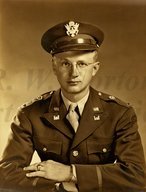
|

|
|
|
|
Born in Brush Creek, Tennessee, Gore survived typhoid fever when he was about four years old. The Kemps moved to Florida in the mid-1920s in hopes of improving his mother's health as well as the family's income. They settled in Lake Wales, where his father worked in the citrus industry. His mother was employed in a dry goods store, and later managed homes of wealthy families. Gore, by age "twelve or thirteen," began working on Saturdays in a grocery store, where he was paid two dollars a day. He graduated from Lake Wales High School in 1933, when only sixteen. Believing he needed some "postgraduate work," his parents enrolled him at Riverside Military Academy in Gainesville, Georgia, for one year. After working another year in a Lake Wales drugstore, he enrolled at Alabama Polytechnic Institute (now Auburn University) in Auburn, Alabama, and studied mechanical engineering. He also joined Reserve Officers Training Corps (ROTC). In 1939 he earned a bachelor of science in mechanical engineering and was commissioned as a second lieutenant in the US Army Corps of Engineers, but was not sent immediately into active duty. Friends of the family, who owned Lord Baltimore Press in Baltimore, offered Gore a trainee position. He worked there briefly, then gained employment at Koppers Company, a piston ring manufacturer and a Fortune 500 company. He worked in sales engineering until March 1941 when he received orders for active duty. After reporting to Fort Meade, Maryland, he was sent to Fort Bragg in North Carolina, where he was assigned to the 15th Engineer Combat Battalion, part of the 9th Infantry Division. Soon after the attack on Pearl Harbor he completed a six-week refresher course in the Engineers School at Fort Belvoir in Virginia. He remained there two years as an instructor, teaching courses in land mines and bridge construction to Officer Candidate School (OCS) personnel. He then was sent to the 258th Engineer Battalion at Camp Shelby near Hattiesburg, Mississippi, where he was understudy to an executive officer, whose place he took when the unit sailed to Great Britain on the SS Brazil. After crossing the English Channel near Christmas of 1944, the battalion was sent to Gulpen, Holland, near the fighting in the Battle of the Bulge. His unit's task was to clear minefields, keep roads open, and build Bailey bridges for stream crossings. He recalls constructing a pontoon bridge across the Ruhr River. At the Rhine his unit ran assault boats across the river, while the 202nd Engineer Battalion built a pontoon bridge to span the stream. After crossing the Rhine, he was placed in charge of the 202nd Engineer Battalion, whose commanding officer had been wounded. The unit formed the "very left flank" of the 9th Army as it entered the Ruhr Valley. As the Allies began liberating death and concentration camps, he recalls, General Dwight D. Eisenhower ordered each unit within range of such a facility to "send a contingent to observe that; visit, tour it, and to come back and tell everybody that didn't go about it," he recalls. He sent one man from every squad to such a camp about fifty miles away. Later, his unit helped free a Polish work camp. "That was a mistake," he recalls. "They went out and started looting everything and we had to round them up and get them back in there." After the war in Europe ended he received orders to move the battalion to Ath, Belgium. Gore sailed to the States in late 1945 and was discharged at Fort Dix, New Jersey. (His official discharge date, because of leave he had accrued, was dated March 4, 1946). Returning to work at the Koppers Company, he was sent to the regional sales office in Dallas where he managed the company's efforts in five southwestern states. He was soon promoted to sales manager for the company and returned to Baltimore. Gore left the company in 1952 and returned to Texas where a relative in Kilgore was a drilling contractor. On October 24, 1952, he married Betty Ann Montgomery. (They would have two children and five grandchildren). Gore later built Davis-Kemp Tool Company, an enterprise focusing on down-hole problems in oil wells. It later merged with another company. He wrote a book on the discipline and taught in oilfield schools. His company had sixteen locations when he retired as president. Gore stayed on with the firm as vice-president of the parent company and did training and seminars in such locations as England, Great Britain, Hong Kong, Singapore, and China. |


